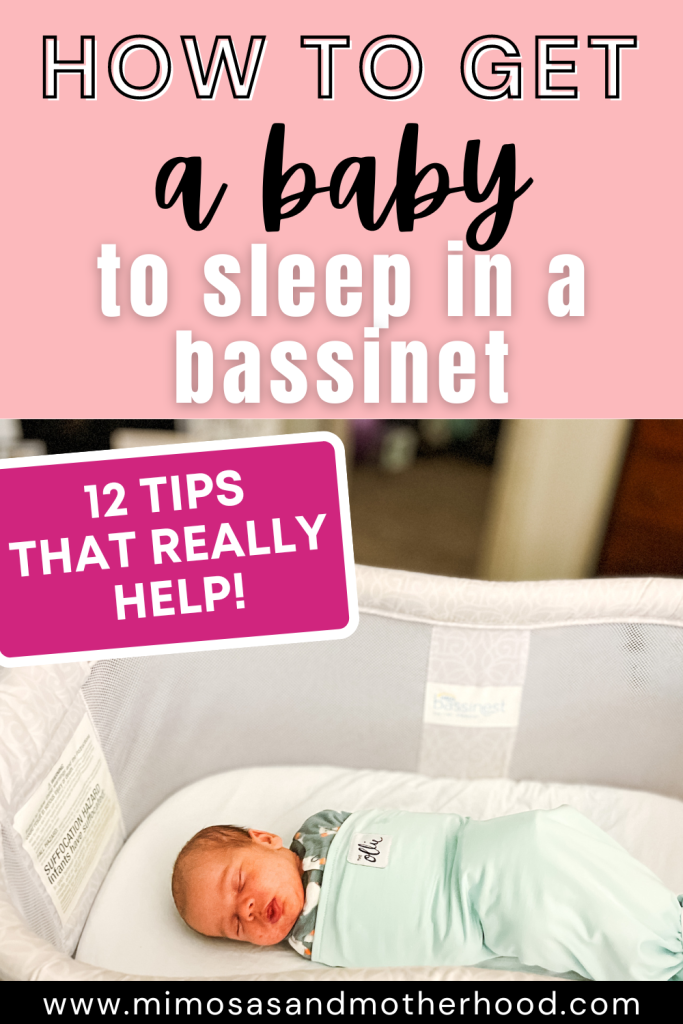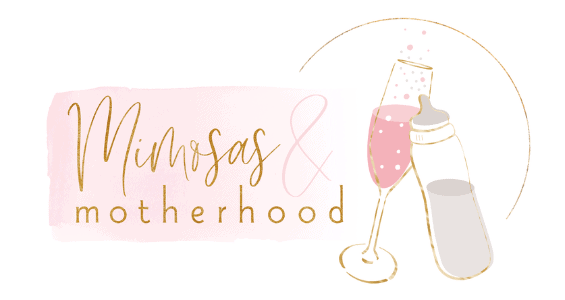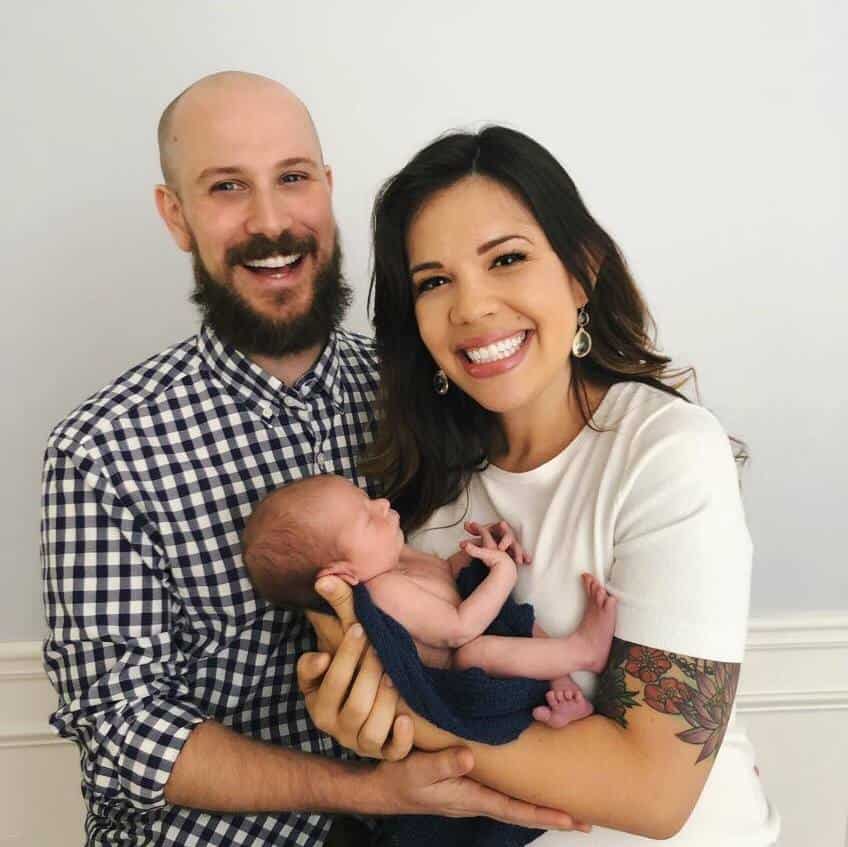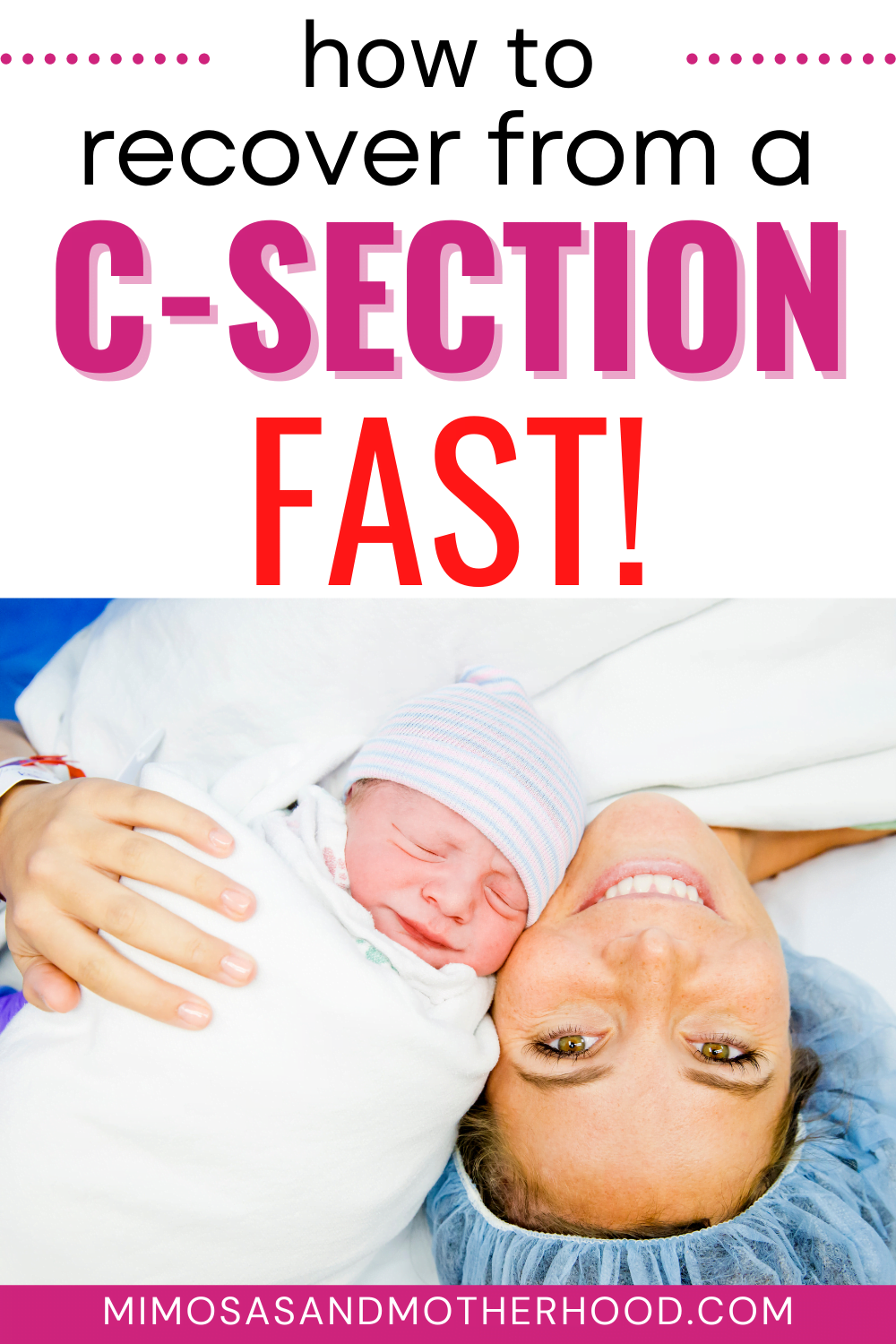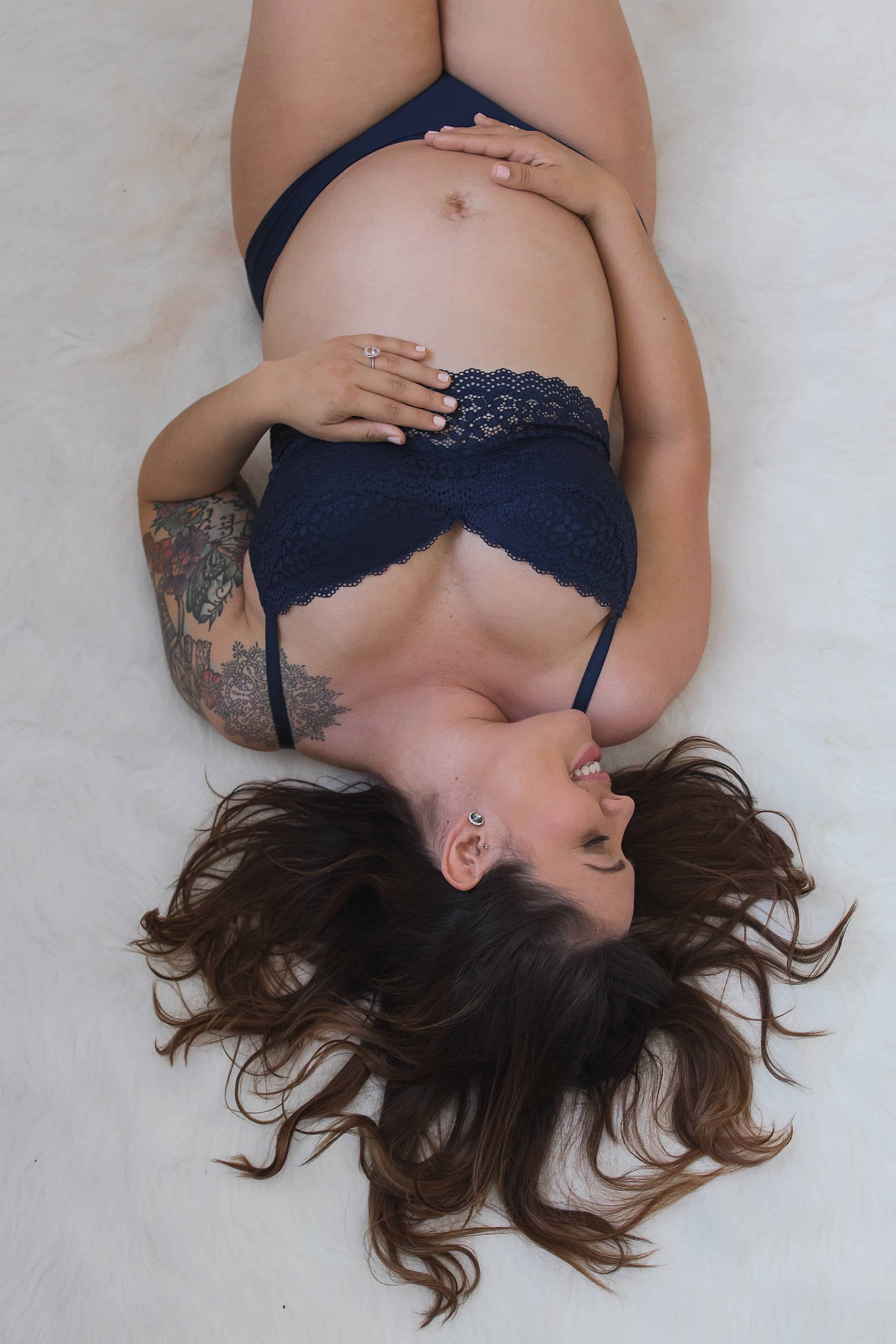How to Get a Baby to Sleep in a Bassinet
Any new parent can tell you how physically and mentally exhausting the first few weeks home with a newborn can be. Struggling to get baby to sleep can make things even more challenging. Wondering how to get baby to sleep in a bassinet? Read on for 12 tips from real moms!
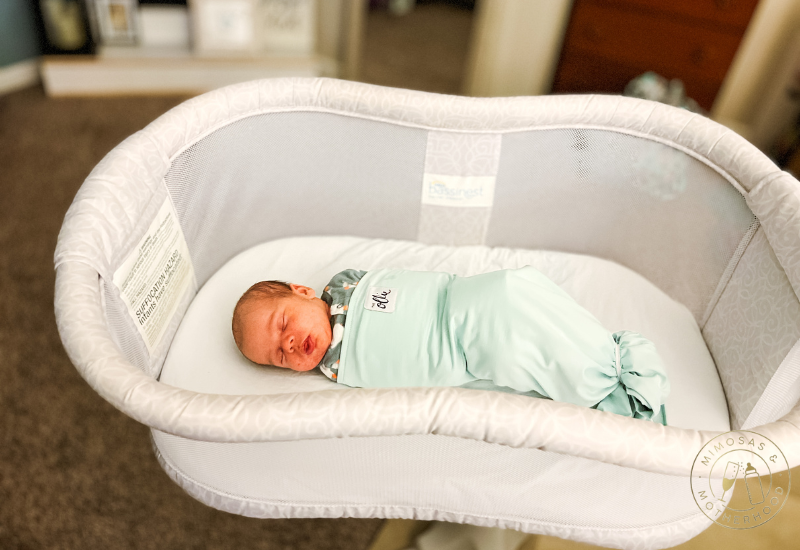
The first few couple of weeks home with a newborn baby are filled with so many truly wonderful moments. One of the ones that remains not so wonderful though for new parents are those middle of the night moments when you’re desperately trying to get your baby to sleep in their bassinet and they firmly are fighting against you.
Whether this is your first baby or your fifth, newborn sleep is challenging. If you’re struggling, please know you’re not alone!
When you’re struggling to get your baby to sleep on their own in the middle of the night, it can feel really tempting to let your baby fall asleep in your arms. How can you say no to that sweet face and snuggles?
But when it comes to sleep, you want to keep safety at the front of your mind. According to the American Academy of Pediatrics safe sleep guidelines, the safest place for your baby to sleep is on a firm, flat surface in their own sleep space, like the firm mattress in baby’s crib or bassinet. This safe sleep guideline helps to reduce the risks of SIDS (Sudden Infant Death Syndrome,)
Not only is safety paramount, but so is thinking about how your baby will sleep when he gets older. You’re laying the groundwork now for good sleep habits as your baby grows.
The drive to sleep is a biological one, but it might surprise you to learn that the way we sleep is a learned habit. Have you ever heard someone say that a baby is “overtired?” That stems from the fact that newborn babies don’t know how to put themselves to sleep when they need it. They need us as parents to help them create those early sleep habits.
Note: Some links may be affiliate links. That means I may make a commission if you use my links to purchase, at no extra added cost to you! I only recommend products that I personally love and believe in. Full disclaimer here.
Is it normal for newborn to hate bassinet?
It’s actually really normal for most babies to struggle with sleeping by themselves in a bassinet or crib. There are a few reasons why a baby might struggle to sleep in a bassinet, whether it’s in their own room or yours. The first is that babies naturally look to other humans to seek comfort, especially mom.
It’s absolutely normal for your newborn to fall asleep more easily for a nap in your arms, and sleep more deeply because they feel safe and secure. I personally have always loved my children falling asleep in my arms for naps, too!
Even with it being incredibly normal for babies to seek this comfort, your baby should still be able to sleep independently in a bassinet too. However, there are a few reasons why your baby might be seeking extra comfort that could be preventing them from being able to sleep easily in a bassinet.
If you think your baby might be struggling with gas or reflux, be sure to hold them for a bit longer upright before putting them down to sleep. My children have all struggled with gas around weeks 4-8, and I’ve found that these gas drops and this kind of gripe water truly helped! I incorporated them into our bedtime routine, giving baby a dose immediately following their nighttime feed, and kept them upright for about 5 minutes before laying down. It made a big difference.
Another reason is your baby might be hungry or dirty! Be sure that your baby has gotten a full feed before bed. If you are concerned about having a low milk supply or a tongue tie, lip tie or other latch issue, try using a bottle for this bedtime feed and see if that helps. Be sure to check their diaper too and see if they need a diaper change.
Is baby swaddled? If not, it might be the startle reflex that’s waking them up! A good swaddle goes far when it comes to helping baby sleep better and sleep longer. Learn more about swaddles here.
Your baby might also be fighting the bassinet because they’re overtired. Like we talked about above, babies need a lot of help with sleep, and many parents mistake signs of fatigue for hunger. Other families might not be putting baby to sleep often enough during the day, waiting for him to fall asleep on his own. Still others might have bedtimes that are too late at night. All of these can make it appear as if your baby hates their bassinet.
Babies also quickly learn habits. If your habit is to rock your baby to sleep in your arms because your newborn won’t sleep unless held, and find that as soon as baby is placed in the bassinet or crib that they wake up and cry, it might be because they have learned that falling asleep happens in your arms. They then look to your arms for that same comfort again. Learn more about establishing a sleep schedule as early as one month here.
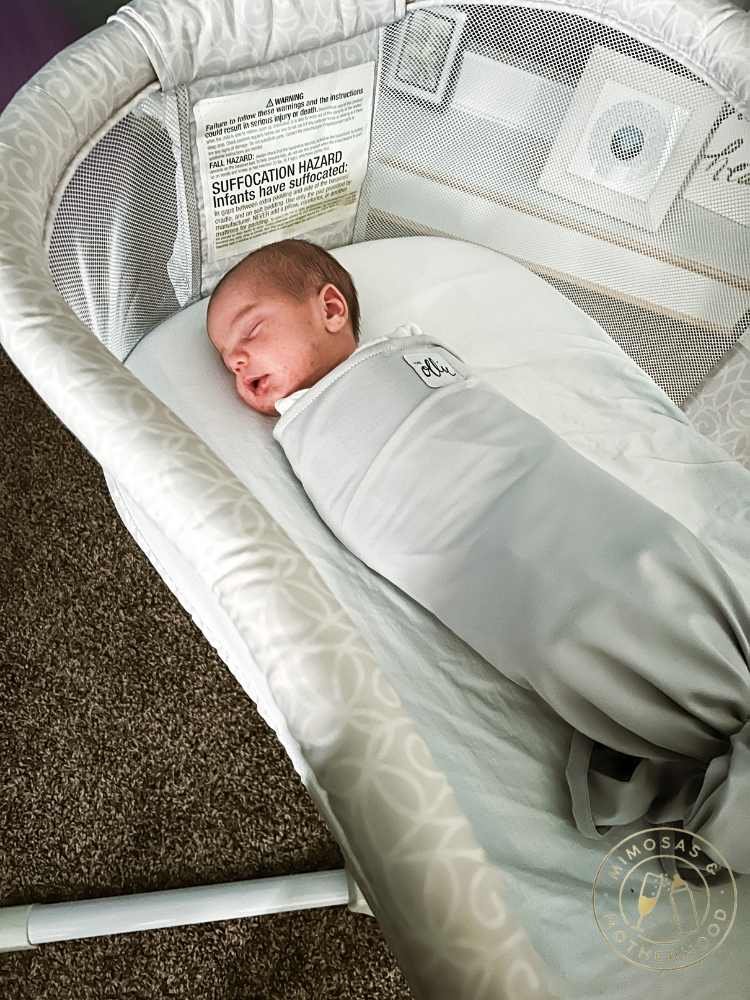
How to Get a Newborn to Sleep in a Bassinet
It’s incredibly frustrating if your baby won’t sleep in a bassinet or bedside sleeper, but there are a few things you can do to help!
- Check if there’s a reason preventing baby from sleeping, like:
- Gas/Reflux
- Hungry
- Dirty Diaper
- Laying in a cold spot from spit up
2. Check the temperature of the room and be sure it’s not too hot or too cold. The room temperature should be comfortably cool, in the 68-72 °F range (20° to 22.2°C).
3. Swaddle! Don’t let that baby fool you into thinking they hate the swaddle and shouldn’t use it. Flailing limbs and the startle reflex can ruin even the best sleep at this age. Most babies will fight a swaddle, but if you find the right one you’ll soon see it makes a huge impact on their sleep. Our family uses and loves The Ollie Swaddle. It’s the only swaddle on the market that has been able to accommodate all three of our kids and their very different sizes as newborns! In fact, all of these photos show my son sleeping soundly in his bassinet wearing an Ollie Swaddle.
4. Establish a daytime schedule and routine with set times for nap time as well as awake times. Most newborns need to sleep most of the day, with short wake windows. If your baby is awake too much, they can become overtired which actually makes it harder for your baby to fall asleep and stay asleep.
5. Create a consistent bedtime routine as part of your sleep schedule. This consistency begins to subconsciously resonate with your baby that it’s time to sleep longer. Make sure it’s the same every night! Our family does a warm bath, lavender lotion, bedtime bottle, swaddle, a book.
6. Get baby more comfortable with sleeping in a bassinet by starting with the first nap of the day. Many parents find that this nap is the easiest one to get baby to sleep for.
7. Make sure baby’s bassinet is in a dark room. Blackout curtains like these work wonders!
8. Add a white noise machine. Our family loves the Hatch, but there are lots of options on the market that work great too, like this very popular white noise machine.
9. Be sure to put baby down when he’s drowsy but not totally asleep. You want baby to fall asleep in the bassinet, not your arms.
10. Try the heating pad trick. Lay a heating pad on the low setting in the bassinet for a few minutes before placing baby in. The heat mimics the heat from your body and according to parents who have tried this, it can help baby’s who don’t like cold sheets fall asleep. Be sure to only use the LOW setting, as a higher setting is too warm for baby’s skin.
11. Try one last feed. Offer baby your breast or bottle and see if he will take a little bit more. The full tummy can sometimes be the final factor.
What do you do if baby won’t sleep in bassinet?
If your baby won’t sleep in a bassinet, first know you’re not alone. So many parents struggle with infant sleep!
The first thing to do is to see if there are any underlying issues that might be contributing to this.
Dirty: Check and see if baby might need a clean diaper. Some kids will happily sleep with a dirty diaper, while others will complete lose it if theirs is even slightly wet.
Hunger: Is it possible your baby might still be hungry? See if they settle and sleep for a longer stretch with a full tummy.
Gas or Reflux: If your baby isn’t hungry and has a clean diaper, gas might be contributing to the issue. Try giving him a burp again, or give gas drops a try. Gripe water is another option for babies over 4 weeks old. Hold him upright longer after a feed, and be sure to try to get one last burp out before laying him down.
Overtired: If your baby is overtired, you want to work to get him on a schedule that gives him not only plenty of wake time, but structured times to rest too. Below is a sample of what we use for the first few months. Our family has incorporated a gentle version of sleep training, and found that the Moms on Call schedule works really well for us.
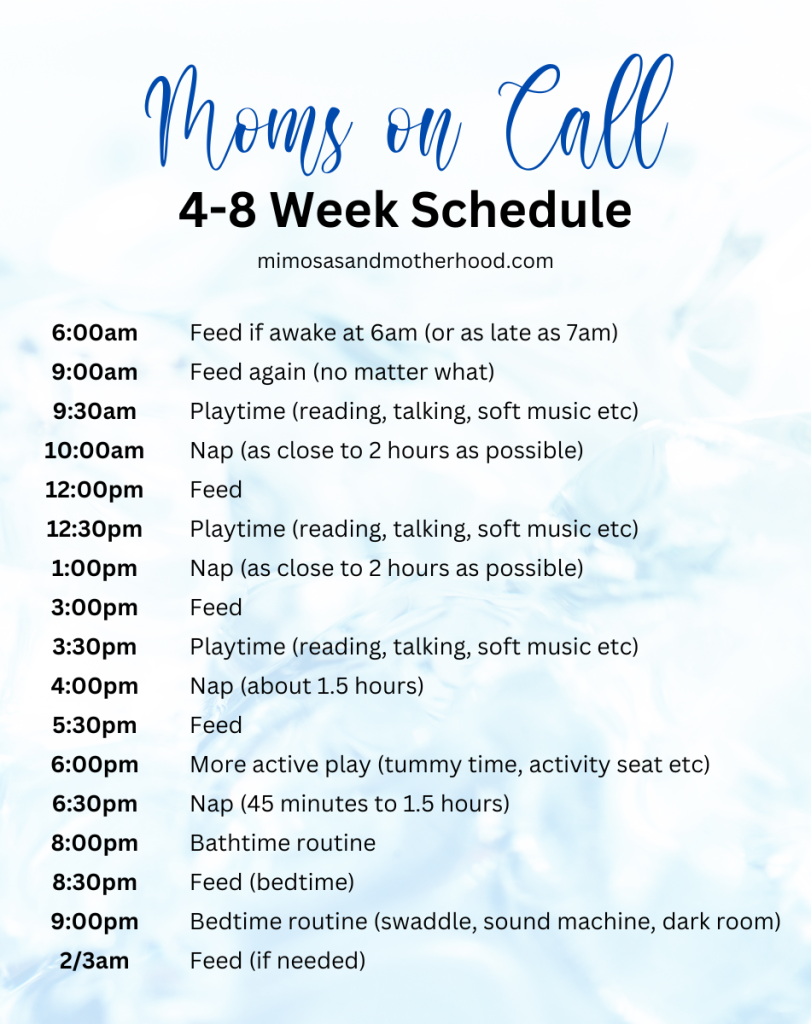
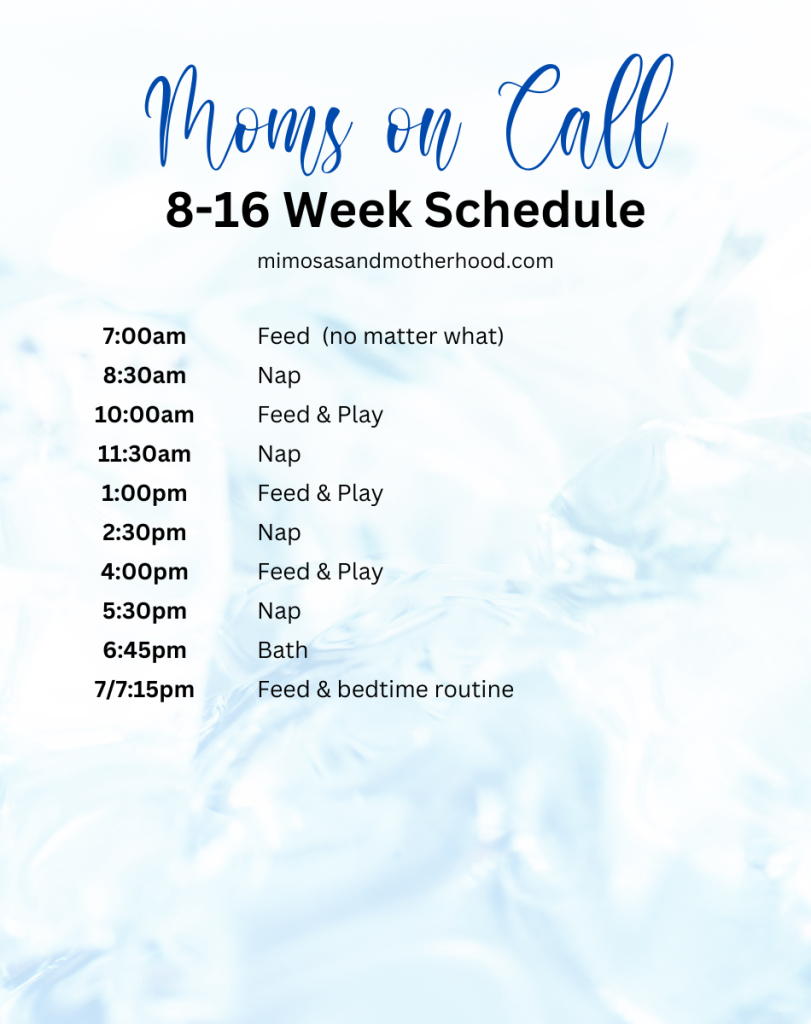
If baby is still struggling consistently, be sure to talk to your pediatrician to rule out any other issues before reaching out to a sleep consultant.
I remember as a first-time mom feeling really anxious whenever my baby would cry, and wanting to immediately rush in and comfort him. The best piece of advice I got from more experienced moms was that it was absolutely ok for my little guy to fuss for a few minutes as long as I knew he was safe.
Giving myself “permission” to not immediately pick him up allowed me to also learn how to comfort him in different ways. I learned that many times he just needed reassurance that I was nearby and he wasn’t all alone. Giving him a little verbal shushing and some gentle pats or jiggles many times did the trick.
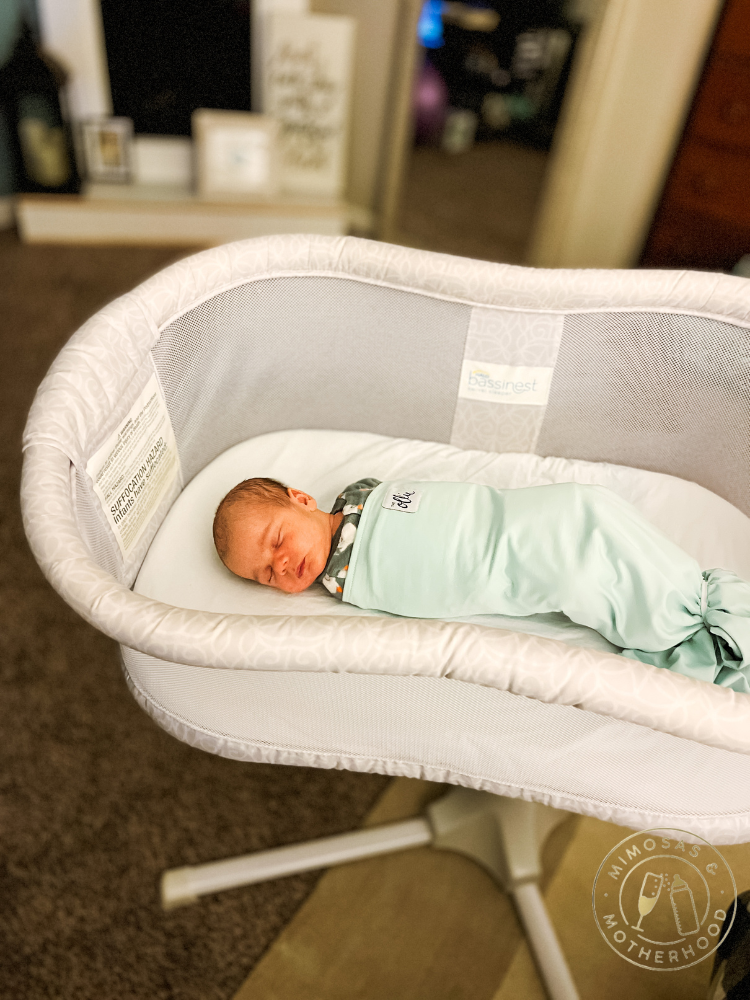
You might also enjoy these articles:
The Best Sleeping Suit for Babies- Baby Merlin’s Magic Sleepsuit Review
The Best Baby Monitor Without Wifi (2022 Update)
How long do babies sleep in a bassinet?
Bedside bassinets give baby a safe place to sleep in those early weeks and months. Most babies can sleep safely in a bassinet for quite some time until they’ve hit the weight limit or they begin pushing up on hands and knees (whichever one comes first). Not all bassinets have the same weight limits. Many traditional bassinets have a weight limit of 15lbs, while some newer bassinets have weight limits as high as 30lbs and more!
Our family has used the Halo BassiNest Swivel Sleeper Bedside Bassinet for all three of our children. The newest model has a 30 pound weight limit!
Weight is just one factor to consider. Most bassinet manufacturers recommend that you stop using a bassinet with your baby when they have reached their first milestone, including:
- Able to sit unassisted
- Can roll over
- Pushing up on hands and knees
- Can pull up on the side of the bassinet
- Reaches the weight limit
Age should also be considered, so be sure to check the weight, height and safety recommendations for your bassinet. Current safety standards say that most babies should transition from the bassinet by 4 – 6 months of age for these safety reasons.
Can baby sleep in a bassinet if rolling over?
Once your baby begins rolling over, it’s no longer safe for your baby to sleep in a bassinet. According to the American Academy of Pediatrics (AAP), once your baby starts rolling they are at a higher risk of suffocation, and therefore your baby should be moved to a crib.
infants don’t have the strength to move their heads and necks the way that we do to get them out of an unsafe position. They could easily roll over into the wall of the bassinet and get stuck in that position. So when your baby begins rolling over, it’s time to begin transitioning them to a crib.
Final Thoughts on How to Get a Baby to Sleep in a Bassinet
The newborn phase goes so fast, but when you’re struggling to get your newborn to sleep in a bassinet it can be really hard to enjoy it fully. Getting baby to sleep for longer periods of time is important not just for them, but for you. Sleep deprivation is incredibly dangerous. A good night’s sleep can do wonders for your mental health and how you physically feel.
A baby needs help establishing healthy sleep habits. Whether you choose for baby to sleep in a baby bassinet, mini crib or portable crib in your master bedroom or a full-size crib in their own room, the most important thing is to be sure it’s a safe environment to help reduce the risk of Sudden Infant Death Syndrome. For the safest sleep they should be on a firm surface (like a crib mattress) free from loose bedding, soft objects (including stuffed animals) loose blankets, bumper pads (or also known as crib bumpers) or other items. Only use a fitted sheet on their firm sleep surface! Baby should never be put to sleep in a car seat or on sleep positioners.
If you found these sleep tips full of helpful information, we would love it if you pinned it on Pinterest or shared on social media to help other parents.
